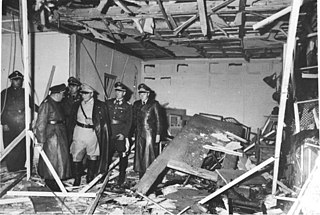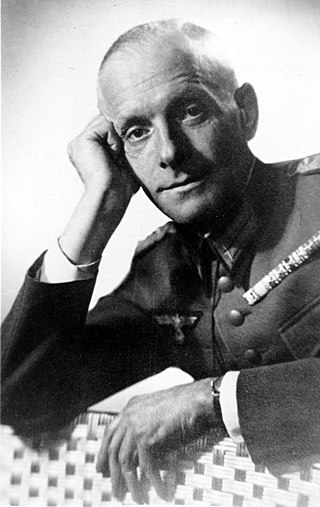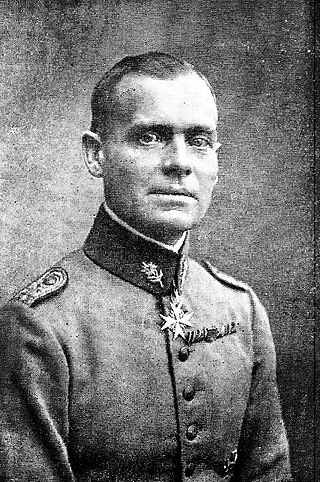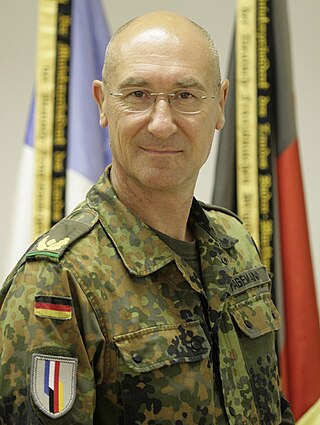Related Research Articles

The 20 July plot was a failed attempt to assassinate Adolf Hitler, the chancellor and leader of Nazi Germany, and overthrow the Nazi regime on 20 July 1944. The plotters were part of the German resistance, mainly composed of Wehrmacht officers. The leader of the conspiracy, Claus von Stauffenberg, tried to kill Hitler by detonating an explosive hidden in a briefcase. However, due to the location of the bomb at the time of detonation, the blast only dealt Hitler minor injuries. The planners' subsequent coup attempt also failed and resulted in a purge of the Wehrmacht.
Generalfeldmarschall was a rank in the armies of several German states and the Holy Roman Empire, (Reichsgeneralfeldmarschall); in the Habsburg monarchy, the Austrian Empire and Austria-Hungary, the rank Feldmarschall was used. The rank was the equivalent to Großadmiral in the Kaiserliche Marine and Kriegsmarine, a five-star rank, comparable to OF-10 in today's NATO naval forces.

Job Wilhelm Georg Erdmann Erwin von Witzleben was a German Generalfeldmarschall in the Wehrmacht during the Second World War. A leading conspirator in the 20 July plot to assassinate Adolf Hitler, he was designated to become Commander-in-Chief of the Wehrmacht in a post-Nazi regime, had the plot succeeded.
Jackboot Mutiny is a 1955 West German film directed by Georg Wilhelm Pabst about the 20 July Plot to assassinate Adolf Hitler. It features Bernhard Wicki as Stauffenberg.

This article details the order of battle of German military units during the invasion of Poland in 1939.

A Generaloberst was the second-highest general officer rank in the German Reichswehr and Wehrmacht, the Austro-Hungarian Common Army, the East German National People's Army and in their respective police services. The rank was equal to a four-star full general but below a general field marshal. The rank was equivalent to a Generaladmiral in the Kriegsmarine until 1945 or to a Flottenadmiral in the Volksmarine until 1990. It was the highest ordinary military rank and the highest military rank awarded in peacetime; the higher rank of general field marshal was awarded only in wartime by the head of state. In general, a Generaloberst had the same privileges as a general field marshal.

Island Farm, also called Camp 198, was a prisoner of war camp on the outskirts of the town of Bridgend, South Wales. It hosted a number of Axis prisoners, mainly German, and was the scene of the largest escape attempt by German POWs in Britain during World War II. Near the end of the war it was renamed Special Camp XI and used to detain many senior SS military leaders who were awaiting extradition to the Nuremberg trials.
Army Group B was the name of four distinct German army group commands that saw action during World War II.

The Courland Pocket was an area of the Courland Peninsula where Army Group North of Nazi Germany and the Reichskommissariat Ostland were cut off and surrounded by the Red Army for almost a year, lasting from July 1944 until 10 May 1945.
During World War II, the Axis invasions of Greece and Yugoslavia both commenced on 6 April 1941 and ended 3 May 1941.

Wilhelm Emanuel Burgdorf was a German general who rose to prominence during the final years of World War II. Burgdorf served as a commander of 529th Infantry Regiment from May 1940 to April 1942. In October 1944, Burgdorf assumed the role of the chief of the Army Personnel Office and chief adjutant to Adolf Hitler. In this capacity, he played a key role in the forced suicide of Field Marshal Erwin Rommel. Burgdorf committed suicide inside the Führerbunker on 2 May 1945 at the conclusion of the Battle of Berlin.

The Oster Conspiracy, also called the September Conspiracy, of 1938 was a proposed plan to overthrow German Führer Adolf Hitler and the Nazi regime if Germany went to war with Czechoslovakia over the Sudetenland. It was led by Generalmajor Hans Oster, deputy head of the Abwehr, and other high-ranking conservatives within the Wehrmacht who opposed the regime for behavior that was threatening to bring Germany into a war that they believed it was not ready to fight. They planned to overthrow Hitler and the Nazi regime through a storming of the Reich Chancellery by forces loyal to the plot to take control of the government, who would either arrest or assassinate Hitler, and restore the Monarchy under Prince Wilhelm of Prussia, the grandson of Wilhelm II.
This is the German Army order of battle on the outbreak of World War I in August 1914.

The Pilot/Observer Badge was a World War II German military decoration awarded to Luftwaffe service personnel who had already been awarded the Pilot's Badge and Observer Badge. It was instituted on 26 March 1936 by the Commander in Chief of the Luftwaffe Hermann Göring. It was worn on the lower part of the left breast pocket of the service tunic, underneath the Iron Cross 1st Class if awarded. It was to replace the older 1933 Aircrew Badge.

Heinrich Kirchheim was a German generalleutnant who served in both World War I and World War II. He is also one of few German officers who were awarded the Pour le Mérite and the Knight's Cross of the Iron Cross. He also served as a deputy member on the "Court of Military Honour," a drumhead court-martial that expelled many of the officers involved in the 20 July Plot from the Army before handing them over to the People's Court.
Generalleutnant Ernst Maisel was a general in the Wehrmacht of Nazi Germany during World War II.

General of the Infantry is a former rank of the German army. It is currently an appointment or position given to an OF-8 rank officer, who is responsible for particular affairs of training and equipment of the Bundeswehr infantry.

General der Panzertruppe was a General of the branch rank of the German Army, introduced in 1935. A General der Panzertruppe was a lieutenant general, above major general (Generalleutnant), commanding a Panzer corps.
The General Honour Decoration was a civil and military decoration of the Grand Duchy of Hesse. Established 25 September 1843, the medal could be awarded to recognize several different accomplishments or merits, such as military merit, lifesaving and long service. The reason for the award of the medal was determined by the inscription on the reverse of the medal, with the obverse bearing the effigy of the reigning Grand Duke of Hesse.
References
- ↑ "German film looks at ties between Rommel and Hitler". BBC News. November 2, 2012.
- ↑ "Row over film that portrays Rommel as more rat than fox". The Independent. October 27, 2012.